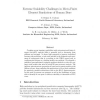Free Online Productivity Tools
i2Speak
i2Symbol
i2OCR
iTex2Img
iWeb2Print
iWeb2Shot
i2Type
iPdf2Split
iPdf2Merge
i2Bopomofo
i2Arabic
i2Style
i2Image
i2PDF
iLatex2Rtf
Sci2ools
102
Voted
CONCURRENCY
2010
2010
Extreme scalability challenges in micro-finite element simulations of human bone
Coupling recent imaging capabilities with microstructural finite element (microFE) analysis offers a powerful tool to determine bone stiffness and strength. It shows high potential to improve individual fracture risk prediction, a tool much needed in the diagnosis and treatment of osteoporosis that is, according to the WHO, second only to cardiovascular disease as a leading health care problem. We adapted a multilevel preconditioned conjugate gradient method to solve the very large voxel models that arise in microFE bone structure analysis. The intricate microstructure properties of bone lead to sparse matrices with billions of rows, thus rendering this application to be an ideal candidate for massively parallel architectures such as the BG/L Supercomputer. In this work we present our progress as well as the challenges we were able to identify in our quest to achieve scalability to thousands of CPU cores.
CONCURRENCY 2010 | Fracture Risk Prediction | Microstructural Finite Element | Multilevel Preconditioned Conjugate |
| Added | 09 Dec 2010 |
| Updated | 09 Dec 2010 |
| Type | Journal |
| Year | 2010 |
| Where | CONCURRENCY |
| Authors | Constantine Bekas, Alessandro Curioni, Peter Arbenz, Cyril Flaig, G. Harry van Lenthe, Ralph Müller, A. J. Wirth |
Comments (0)

